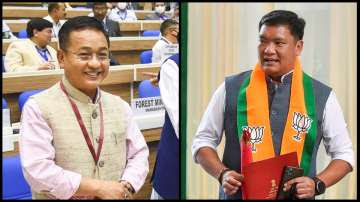In the recently concluded Assembly elections in Sikkim and Arunachal Pradesh, the incumbent parties emerged amazing victorious .
Table of Contents
source : NDTV
1. Arunachal Pradesh:
In Arunachal Pradesh, ten BJP candidates were elected unopposed, which means the counting was done for the remaining 50 out of 60 Assembly seats.
2. BJP’s Victory:
The Bharatiya Janata Party (BJP) secured a comfortable victory in Arunachal Pradesh by winning 46 out of the 50 seats for which counting took place. This strong performance reflects the party’s popularity and support in the state.
3. Ally’s Success:
The National People’s Party (NPP), led by Conrad Sangma, who is also the Chief Minister of Meghalaya, won five seats in Arunachal Pradesh. This alliance with the BJP has proven to be successful in securing a significant number of seats.
4. Prime Minister’s Response:
Prime Minister Narendra Modi expressed his gratitude to the people of Arunachal Pradesh for their support. He took to social media to thank the voters and stated that the election results reflect an unequivocal mandate for the politics of development
5. Party’s Commitment:
PM Modi assured the people of Arunachal Pradesh that the BJP will continue to work with even greater vigour for the state’s growth.

. He praised the hard work of BJP workers and reiterated the party’s dedication to the welfare and progress of the state.known as the “land of the rising sun,” has shown its trust in the Bharatiya Janata Party (BJP) by electing its candidates.
Two state election:
Khandu also made a statement suggesting that the victory in Arunachal Pradesh indicates a potential third term for Prime Minister Narendra Modi.
Moving on to Sikkim, the incumbent Sikkim Krantikari Morcha (SKM) party emerged victorious by winning 31 out of 32 seats in the Assembly elections. The Opposition party, Sikkim Democratic Front (SDF), managed to secure only one seat.
Chief Minister Prem Singh Tamang, also known as PS Golay, expressed his gratitude to the people of Sikkim and the party workers for their support. He acknowledged their hard work and dedication in serving the people, which he believes contributed to the party’s overwhelming victory.
The Sikkim Krantikari Morcha’s success in securing such a large majority indicates the strong mandate given by the people of Sikkim, who have shown their trust in the party’s leadership and vision for the state’s development.
The Sikkim Democratic Front’s limited success reflects the shift in political dynamics and the preference of the electorate for a change in leadership.
Both the election results in Arunachal Pradesh and Sikkim highlight the significance of developmental initiatives and public welfare in influencing voters’ decisions. The victories of the incumbent parties in both states indicate a level of satisfaction among the electorate with the work done by these parties during their time in power.
Pawan Chamling, the leader of the Sikkim Democratic Front (SDF) party, has suffered a significant setback in the recent elections. Chamling, who held the distinction of being the longest-serving Chief Minister in the country, contested from two seats in the elections but was unsuccessful in both.
This defeat marks a significant turning point in Chamling’s political career, as he had been in power in Sikkim for an uninterrupted period of 25 years.
During his tenure as Chief Minister, Chamling implemented various policies and initiatives aimed at the development and progress of Sikkim. His government focused on sectors such as tourism, agriculture, and education, which contributed to the state’s growth and garnered praise from many quarters.
However, the election results indicate a shift in the political landscape of Sikkim. The people of the state have chosen to place their trust in the incumbent Sikkim Krantikari Morcha (SKM) party, led by Prem Singh Tamang. This change in leadership reflects the electorate’s desire for a fresh approach and new ideas for the state’s development.
Chamling’s loss in both seats he contested signifies a significant political setback for him personally and for the SDF party.
It also highlights the changing aspirations and expectations of the people of Sikkim, who have chosen to embrace a new political narrative and direction.Despite this defeat, Pawan Chamling’s legacy as the longest-serving Chief Minister in the country remains intact. His contributions to the development of Sikkim and his long tenure in office have left a lasting impact on the state.
It will be interesting to observe how the political landscape of Sikkim evolves in the aftermath of this election, as the new government takes charge and endeavors to fulfill the aspirations of the people. In Arunachal Pradesh, ten BJP candidates were elected unopposed, and the counting was conducted for 50 out of the 60 Assembly seats. The BJP emerged victorious, winning 46 seats, while its ally, the National People’s Party led by Conrad Sangma, secured five seats. In the Assembly elections in Sikkim and Arunachal Pradesh, the BJP emerged victorious in Arunachal Pradesh, winning 46 out of 50 seats counted, while its ally, Conrad Sangma’s National People’s Party, secured five seats.
Prime Minister Narendra Modi expressed gratitude to the people for their support. In Sikkim, the incumbent Sikkim Krantikari Morcha party won 31 out of 32 seats, with the opposition Sikkim Democratic Front winning just one seat. Pawan Chamling, the longest-serving Chief Minister in the country, lost in both seats he contested. The Congress, NCP, and People’s Party of Arunachal won seats in Arunachal Pradesh.
The voter turnout was 79% in Sikkim and 82.7% in Arunachal Pradesh. The counting of votes for Lok Sabha seats will take place on June 4.



2 Comments
Pingback: PM Modi Thanks Arunachal, Congratulates SKM on Sikkim Win
Pingback: Arunachal Pradesh: BJP Triumphs in State Elections, Pema Khandu Retains Chief Minister ship